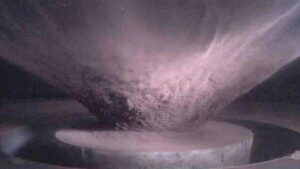
Once upon a time, we thought asteroids were just bland rocks. Turns out, if you actually look at them from up close, they are complex and interesting. When the Dawn mission visited the largest asteroid, Ceres, it discovered ice volcanoes and a geologically diverse landscape. … and complex organic molecules. How the kinds of chemistry necessary for life can end up on a very beat up, icy, inhospitable world is a bit of a mystery.
And scientists are here to solve mysteries.
Researchers at the Geological Society of America Connects meeting presented new research that compares the locations of organics on Ceres with the impact history of the world.
Researchers used the NASA Ames Vertical Gun Range to bombard simulated Ceres samples. These human made compounds look like what we saw on Ceres and are letting researchers try things we just don’t have the tech to try at Ceres. Specifically, they are shooting things at the artificial surface at speeds of 2-6 km/s with impact angles between 15 and 90 degrees. This is letting them test if small impactors – incoming micro meteors and their somewhat larger cousins – can break up the specific kinds of molecules seen at Ceres. They are then comparing what remains after impact with what is seen in different regions on Ceres.
According to team researcher Terik Daly, “Although researchers have performed impact and shock experiments on various types of organics in the past,” says Daly, “what was missing was a study dedicated to the type of organics detected on Ceres using the same type of analytical method used by the Dawn spacecraft to detect them.”
On Ceres, organics were found on older surfaces that also showed evidence of water. According to researcher Juan Rizos, “We can see a very good correlation of organics with [areas] from older impacts and with other minerals like carbonates that also indicate the presence of water. While the origin of the organics remains poorly understood, we now have good evidence that they formed in Ceres and likely in the presence of water.”
We currently believe Ceres could have sub-surface reservoirs of water, and now, Rizos explains, “There is a possibility that a large interior reservoir of organics may be found inside Ceres. So, from my perspective, that result increases the astrobiological potential of Ceres.”
Now, we just need to understand how hard or easy it is for organics to form into life… but that is research for the future.
